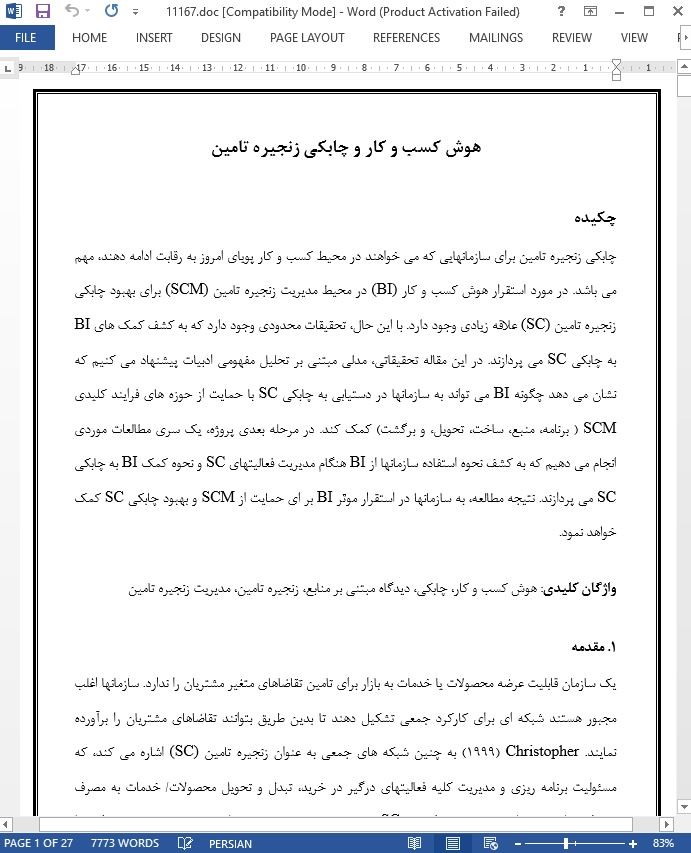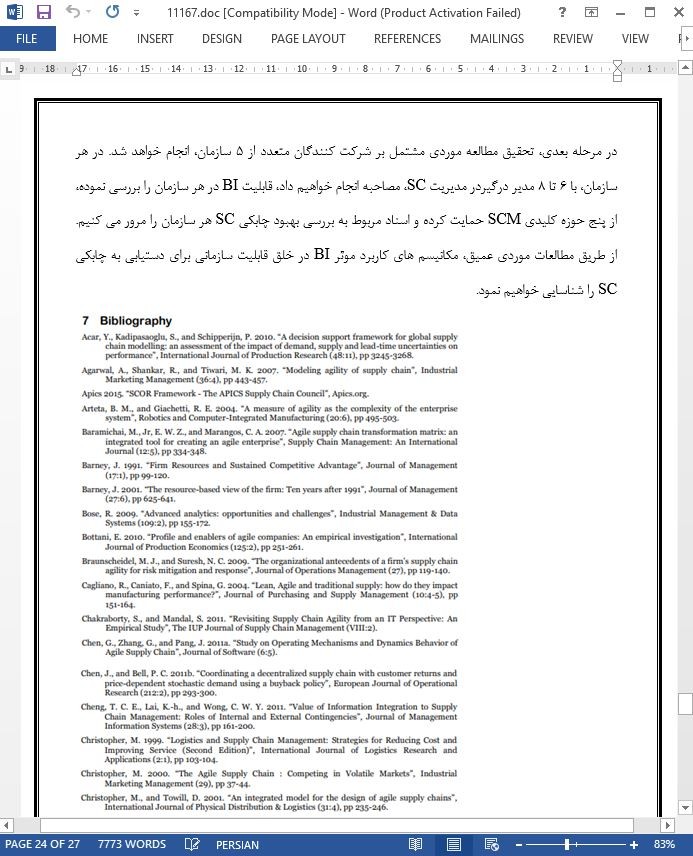
هوش کسب و کار و چابکی زنجیره تامین
چکیده
چابکی زنجیره تامین برای سازمانهایی که می خواهند در محیط کسب و کار پویای امروز به رقابت ادامه دهند، مهم می باشد. در مورد استقرار هوش کسب و کار (BI) در محیط مدیریت زنجیره تامین (SCM) برای بهبود چابکی زنجیره تامین (SC) علاقه زیادی وجود دارد. با این حال، تحقیقات محدودی وجود دارد که به کشف کمک های BI به چابکی SC می پردازند. در این مقاله تحقیقاتی، مدلی مبتنی بر تحلیل مفهومی ادبیات پیشنهاد می کنیم که نشان می دهد چگونه BI می تواند به سازمانها در دستیابی به چابکی SC با حمایت از حوزه های فرایند کلیدی SCM ( برنامه، منبع، ساخت، تحویل، و برگشت) کمک کند. در مرحله بعدی پروژه، یک سری مطالعات موردی انجام می دهیم که به کشف نحوه استفاده سازمانها از BI هنگام مدیریت فعالیتهای SC و نحوه کمک BI به چابکی SC می پردازند. نتیجه مطالعه، به سازمانها در استقرار موثر BI بر ای حمایت از SCM و بهبود چابکی SC کمک خواهد نمود.
1. مقدمه
یک سازمان قابلیت عرضه محصولات یا خدمات به بازار برای تامین تقاضاهای متغیر مشتریان را ندارد. سازمانها اغلب مجبور هستند شبکه ای برای کارکرد جمعی تشکیل دهند تا بدین طریق بتوانند تقاضاهای مشتریان را برآورده نمایند. Christopher (1999) به چنین شبکه های جمعی به عنوان زنجیره تامین (SC) اشاره می کند، که مسئولیت برنامه ریزی و مدیریت کلیه فعالیتهای درگیر در خرید، تبدل و تحویل محصولات/ خدمات به مصرف کنندگان را برعهده دارند. شرکت کنندگان در SC باید در کنار هم کار کنند تا بتوانند تقاضاهای مصرف کنندگان را تامین نمایند به جای اینکه با یکدیگر رقابت کنند. بنابراین، طبیعت رقابت از سازمان در برابر سازمان به زنجیره تامین در برابر زنجیره تامین جابجا شده است (Ketchen و همکاران، 2007). در محیط پویای امروز، یکی از عوامل حیاتی در مدیریت SC انعطاف پذیری است، به گونه ای که سازمانها می توانند با تغییرات بازار مقابله کنند و این تغییرات را به فرصتها تبدیل کنند (Agarwal و همکاران، 2007). مفهوم SC چابک برای تعریف قابلیت SC معرفی شده است که به سازمان توانایی پاسخگویی به تغییرات غیر قابل پیش بینی و عدم قطعیت ها در محیط کسب و کار پویا را می دهد. دستیابی به چابکی SC چالش برانگیز است و به یک موضوع تحقیقاتی تبدیل شده است که در طول دهه گذشته بسیار مورد علاقه بوده است.
6. نتیجه گیری و مطالعه آتی
پیچیدگی SCM دستیابی به یک SC چابک را چالش برانگیز می کند. در این مقاله، راجع به پتانسیل کاربرد BI در فرایندهای SCM برای کمک به مدیران در کاهش عدم قطعیت وظیفه و اخذ تصمیمات آگاهانه تر بحث می کنیم که نهایتاً به دستیابی به چابکی SC کمک می کنند. براساس مروری بر ادبیات موجود، شکاف های موجود در درک فعلی راجع به چگونگی دستیابی به چابکی SC را شناسایی کردیم. برخی از مطالعات موجود دریافتند که در جریان دستیابی به چابکی SC، IT به عنوان یک ابزار عمل می کند. با این حال، در اکثر آن مطالعات، IT در سطح گسترده مورد توجه قرار گرفته است. احتمالاً، مولفه های مختلف IT نظیر ERP، BI، اینترنت و غیره، اثرات متفاوتی بر چابکی SC اعمال می کنند. علاوه براین، اکثر مطالعات موجود جنبه های جزئی فرایندهای SCM و چابکی SC را پوشش می دهند. بنابراین، به مطالعه ای جامع با تمرکز بر ابزارهای خاص IT، کلیه فرایندهای کلیدی SCM و کلیه مولفه های کلیدی چابکی SC نیاز می باشد.
Abstract
Supply Chain Agility is vital for organisations wanting to remain competitive in today’s dynamic business environment. There is increasing interest in deploying Business Intelligence (BI) in the Supply Chain Management (SCM) context to improve Supply Chain (SC) Agility. However, there is limited research exploring BI contributions to SC Agility. In this research-in-progress paper we propose a model based on a conceptual analysis of the literature showing how BI can help organisations achieve SC Agility by supporting the key areas of SCM (Plan, Source, Make, Deliver, and Return). In the next stage of this project, we will conduct a series of case studies investigating how organisations use BI when managing their SC activities and how BI contributes to SC Agility. The result of the study will help organizations deploy BI effectively to support SCM and improve SC Agility.
1 INTRODUCTION
A single organization is unlikely to have the full capability of bringing products or services to the market to meet changing customer demands. Organizations are frequently forced to form a network to work collectively to meet customer demands. Christopher (1999) refers to such a collective network as a Supply Chain (SC), which is responsible for the planning and management of all activities involved in acquisition, conversion, and delivery of products/services to consumers. SC participants need to work closely together to meet consumer demands rather than competing against each other. Therefore, the nature of competition has shifted from ‘organization against organization’ to ‘Supply Chain against Supply Chain’ (Ketchen et al. 2007). In today’s dynamic environment, flexibility is critical in managing SC so that organisations can deal with market changes and convert these changes into opportunities (Agarwal et al. 2007). The concept of Agile SC has been introduced to define the SC capability that enables an organization to respond to unpredictable changes and uncertainties in dynamic business environment. Achieving SC Agility is challenging and has become a research topic of increasing interest over the last decade.
6 Conclusion and Future Study
Achieving an agile SC is challenging because of the complexity involved in SCM. In this paper, we discuss the potential for BI use in SCM processes to assist managers in reducing task uncertainty, and making more informed decisions which ultimately assist in achieving SC agility. Based on our review of the existing literature, we identified a number of gaps in the current understanding regarding how SC Agility is achieved. Some existing studies found that IT can be instrumental in achieving SC Agility. However, IT has been considered in a broad sense in most of those studies. Arguably, different IT components such as ERP, BI, Internet and so on may have different effects on SC Agility. In addition, most of the existing studies cover partial aspects of SCM processes and SC Agility. Hence, a comprehensive study is required focusing on specific IT tools, all key SCM processes and all key components of SC Agility.
چکیده
1. مقدمه
2. پیشینه
1. 2. مدیریت زنجیره تامین
2. 2. چابکی در SC
3. 2. پتانسیل هوش کسب و کار (BI)
4. 2. مطالعات موجود مرتبط با BI، SCM و چابکی SC
5. 2 شکاف های تحقیق
3. بنیان نظری
1. 3. دیدگاه مبتنی بر منابع (RBV)
2. 3. تئوری پردازش اطلاعات سازمانی (OIPT)
4. مدل تحقیق و توسعه پیشنهاد
5. روش تحقیق
6. نتیجه گیری و مطالعه آتی
Abstract
1 INTRODUCTION
2 BACKGROUND
2.1 Supply Chain Management
2.2 Agility in SC
2.3 The potential of Business Intelligence (BI)
2.4 Existing studies related to BI, SCM and SC Agility
2.5 Research Gaps
3 Theoretical foundation
3.1 Resource Based View (RBV)
3.2 Organization Information Processing Theory (OIPT)
4 RESEARCH MODEL AND PROPOSITION DEVELOPMENT
5 Research Methodology
6 Conclusion and Future Study
- اصل مقاله انگلیسی با فرمت ورد (word) با قابلیت ویرایش
- ترجمه فارسی مقاله با فرمت ورد (word) با قابلیت ویرایش، بدون آرم سایت ای ترجمه
- ترجمه فارسی مقاله با فرمت pdf، بدون آرم سایت ای ترجمه



